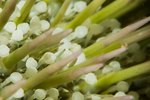
Daphnia are planktonic crustaceans. They also are called water fleas because they not only look like land fleas. but also swim in a jumpy, spastic manner that resembles the way fleas move. Daphnia are semi-transparent organisms. They swim using their very large antennae to propel themselves through water. Because of their size and density, Daphnia are not strong swimmers and cannot handle strong currents, keeping instead to the water column. In fact, if they stop swimming, Daphnia quickly sink rather than float.
Natural Habitat
Daphnia are found mainly in bodies of open fresh water, ranging in size from puddles to huge lakes. Daphnia found in lakes that also are home to fish that feed on it and other plankton tend to be smaller and more transparent than Daphnia that live in water that is free of predators. Invertebrates also feed on Daphnia. Daphnia subsist on a diet of single-celled algae, bacteria and yeast, which they feed on as they propel themselves through the water. Because they are a food source for fish and invertebrates and also keep levels of algae and bacteria in check, they are an essential part of the food chain.
Migrating for Food
Daphnia tend to migrate upward toward the water’s surface at night, and head back down to the relative safety of the depths during the day. Because their habitat is shared by predators, this behavior helps luckier Daphnia escape becoming the main course while looking to feed themselves. Fish that hunt them during the day won’t spot them hiding in the darker depths, and when they emerge to the surface at nighttime, they have access to the planktonic algae in their habitat.
pH Balanced for a Daphnia
Daphnia tend to keep to bodies of fresh water, but some species of Daphnia can survive a high salinity of up to 20 percent seawater. Typically, Daphnia live in water with a salinity of no more than 5 percent. Most species of Daphnia will thrive in waters with a pH range of between 6.5 and 9.5, but the ideal pH range is between 7.2 and 8.5.
Survival of the Fittest
Fish that hunt Daphnia prefer the larger of their species, which are easier for fish to spot, and make for a more fulfilling meal than the tinier Daphnia. Curiously, larger Daphnia avoid bodies of water that have planktivorous fish. Since they are not strong swimmers, larger Daphnia that come in contact with planktivorous fish are as good as toast. They also have evolved as a result of their habitat and surrounding, and produce smaller offspring to ensure their survival against their fishy predators. Similarly, smaller Daphnia usually are consumed by invertebrates. These smaller Daphnia species have evolved to produce larger offspring to avoid getting eaten.
References
Photo Credits
-
Thinkstock/Comstock/Getty Images
Writer Bio
Vivian Gomez contributes to Retailing Today, the Daily Puppy, Paw Nation and other websites. She's covered the New York Comic Con for NonProductive since 2009 and writes about everything from responsible pet ownership to comic books to the manner in which smart phones are changing the way people shop. Gomez received her Bachelor of Arts in English literature from Pace University.



